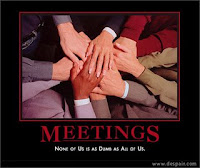 Making meetings more productive and effective is a lot easier than one might think. Here are some ways to get the most of out of your meetings ...
Making meetings more productive and effective is a lot easier than one might think. Here are some ways to get the most of out of your meetings ...1. Have an agenda:
The worst thing you can do is set up a meeting with the intention of just getting people together to talk. I know whenever I’m in a meeting and the facilitator (or person who set up the meeting) begins with “I set this up so we could all get in the same room and talk about XYZ,” that I should take Mrs. Gump’s advice and run like the wind.
Before inviting people to any meeting, make sure you have a list of goals or outcomes that you expect from the meeting (which may or may not choose to share with the group). Have a list of topics to cover and estimate how much time you should spend on each topic.
2. If you can accomplish your goals with an email or memo, then don’t have the meeting:
Some people like to have meetings for the sake of having meetings - I personally think they feel some sort of power by being able to drag people together. Avoid this temptation because the meeting itself, along with all the preparation work, takes valuable time away from more productive tasks for both you and the meeting invitees.
3. Only invite people that need to be there:
Sometimes we feel the need to bring everyone remotely related to the topic of discussion to a meeting which results in most of the people in the room twiddling their thumbs while they await the 5% of the discussion that pertains to them. If someone only needs to be part of 25% of the discussion or less, either speak with them before the meeting so they don’t have to take time out of their busy day to attend or go over their part during the beginning of the meeting. If you find that there are several people that have just a little to contribute to the meeting, you may be better off having a quick conversation and sending out an email with what you’ve learned from your conversation as opposed to having the meeting.
Also, if someone has nothing to contribute to what will be discussed in the meeting (or no interest in what’s being discussed), then don’t invite them. Many people invite their bosses or upper management just for the sake of keeping them in the loop. Bringing in people with nothing to contribute may cause them to ask questions for the sake of looking like they’re participating.
4. Limit the meeting to 30 minutes:
You tend to lose people’s attention after 30 minutes so your most productive time will be the first half hour. If you find that you need more than thirty minutes to cover everything on your agenda, then consider having more than one meeting. There are always exceptions, but keep in mind that agendas tend to stretch to fit the time allotted to them. So having a shorter meeting will encourage everyone to stay focused and discourage non-topic related discussions.
5. Take discussions that are of interest to only a few participants offline:
The telltale sign of this is when only two or three participants are involved in the discussion and everyone else is zoning out. If it’s not of interest to the majority of attendees, then take it offline.
6. Don’t allow tangents to last more than a minute:
Tangents happen at practically all meetings - we’re social creatures and need that bonding.
Instead of cutting off all tangents immediately (which may negatively affect the mood of the meeting), interject your thoughts about the tangent and then say something like “but, anyway” and bring the focus back to the topic.
7. Start and finish on-time:
When you invite people to the meeting, explain that you have a limited amount of time so you’ll be starting promptly at whatever time you specified. People will still come in late but will eventually learn that you start and finish on time.
And a bonus tip: don’t divert from your agenda just to catch people up as that will encourage the behavior - tell them you’d be glad to do so after the meeting.
Also, allot time to each item on your agenda and stick with it. It’s especially effective if you have a printed agenda with the allotted time for each item on it.
8. Bring a few extra copies of printed materials:
It’s not uncommon for uninvited guests to show up, especially in a corporate setting where managers may bring people from their teams that they feel could benefit from attending. So instead of having to run out to the copier (or making attendees share), bring a few extra copies which you can always recycle if no one needs them.
9. Get to the meeting location early:
Depending on your situation, your setup time will vary. You’ll want at least 30 minutes if you need to set up a projector or rearrange the room’s set up. You’ll need at least five minutes to organize handouts, makes notes on a white board or put the place back together if another meeting was scheduled in the room before yours.
10. Anticipate questions and discussions as part of your meeting prep:
Preparing well for a meeting (which is a topic in itself) can make things go smoothly. It’s vital that you anticipate questions and discussion points so you can prepare your responses. You can also bring any notes or supporting materials so you can show attendees instead of having to describe it.
[Overnight Sensation]
No comments:
Post a Comment